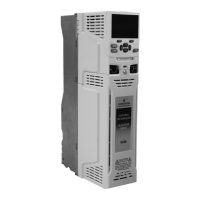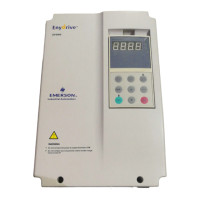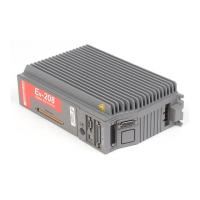Safety
information
Product
information
Mechanical
installation
Electrical
installation
Getting
started
User Menu
A
Commissioning
Advanced
Parameters
Diagnostics Optimization CT MODBUS RTU Technical Data
138 E300 Design Guide
Issue Number: 1
load in order to compensate for speed drop. If slip compensation is required, this parameter should be set to the value from the motor name plate
which should give the correct rpm for a hot machine. Sometimes it will be necessary to adjust this during commissioning, as the nameplate value may
be inaccurate. Slip compensation is disabled if the motor rated speed is set to 0 rpm or to the synchronous speed or if Slip Compensation Enable
(B10) = Off (0).
RFC-A Rated load rpm is used with motor rated frequency to determine the full load slip of the motor which is used by the vector control algorithm.
Incorrect setting of this parameter can result in the following:
• Reduced efficiency of motor operation
• Reduction of maximum torque available from the motor
• Failure to reach maximum speed
• Over-current trips
• Reduced transient performance
• Inaccurate control of absolute torque in torque control modes
The nameplate value is normally the value for a hot machine, however, some adjustment may be required when the drive is commissioned if the
nameplate value is inaccurate. The rated full load rpm can be optimized by the drive (refer to Motor Parameter Adaptive Control (B25)).
RFC-S The motor rated speed is not used by the motor control algorithms, but it is used by the motor thermal protection system. The units for motor
rated speed are always rpm The nameplate value is normally the value for a hot machine. Setting this parameter to 0 disables the motor thermal
protection. For further details on the motor thermal protection system (refer to parameter Thermal Protection Mode (B19)).
A23 (Open Loop Control Mode B09)
(RFC-S Action On Enable B09)
Open loop control mode
The open loop control mode defines the drive output mode. It should be noted that the maximum output voltage of the drive is limited to a level just
below DC bus voltage (J65) / √2 . Therefore if the drive is being supplied via its own rectifier input stage, the output voltage is limited to a level just
below that of the supply voltage. If the drive is operating in voltage mode, the output voltage is limited to A19 (Motor Rated Voltage B03) or the
maximum possible output voltage whichever is the lowest. If (Quasi Square Enable B45) = On (1) the maximum possible output voltage can be
increased.
0: Ur S (Resistance compensation, stator resistance measured at each start) Resistance compensation is a form of stator flux oriented sensorless
motor control. A linear frequency to voltage characteristic is used where the drive output voltage is increased from 0 V to A19 (Motor Rated Voltage
B03) as (Output Frequency J60) increases from 0
Hz
to A21 (Motor Rated Frequency B06).
When the output frequency is above the motor rated frequency, the output voltage is limited to A19 (Motor Rated Voltage B03). Vector based stator
resistance compensation is applied below A21 Motor Rated Frequency (B06) / 4 and is then tapered out from (A21 Motor Rated Frequency B06) / 4
to (A21 Motor Rated Frequency B06) / 2. This method controls the flux level correctly in the motor in the steady state, provided the correct value of
Stator resistance (B34) is used. The stator resistance is measured each time the drive is started.
This test can only be done with a static motor where the flux has decayed to zero. To ensure that the measurement is not carried out before the flux
has decayed, there is a period of one second after the inverter has been disabled during which the test is not carried out if the drive is re-started. B34
Stator resistance is not automatically saved in non volatile memory after each test.
1: Ur (Resistance compensation with no stator resistance measurement) Resistance compensation is used as in Ur S mode, but the stator resistance
is not measured.
2: Fixed (Fixed boost with linear characteristic) A fixed frequency to voltage characteristic is used as shown below where the voltage at 0 Hz is
defined by A17 (Low Frequency Voltage Boost B12).
A23 {B09} Open-Loop: Open Loop Control Mode
{B09} RFC-S: Action On Enable
RW Txt US
OL
Ú
UrS (0) Ur (1) Fixed (2)
Ur Auto (3) Ur I (4)
Ö
Ur I (4)
RFC-A
RFC-S
Disabled (0), Short (1),
Short Once (2),
Long (3), Long Once (4)
Disabled (0)
Value Text
0UrS
1Ur
2Fixed
3Ur Auto
4Ur I

